Rainwater Harvesting – Bending Oak Project in Ohio
- Erik Peterson

Hey permies! In this blog post, we’re going to get the skinny on rainwater harvesting…
Bill asked if I could share with you all the process of designing and installing the rainwater catchment system we constructed for the Youngstown, Ohio permaculture project that Bill and Becky have been leading, known as Bending Oak . So herein we will explore the nuts and bolts of our own install, and give you the essential information that you will need to consider in designing a rainwater harvesting system of your own.
Besides teaching and designing with Bill and Becky I am also co-running our farm Fern Hollow Farm and our permaculture business.
At Bending Oak I have been involved with tending to the fruit and nut orchards, finishing the construction of the shipping container barn, planting native wetland plants around the newly installed pond, and more. Now that the rain catchment system is in place, we’re one big step closer towards off grid, self-sufficiency! So let’s dive in…
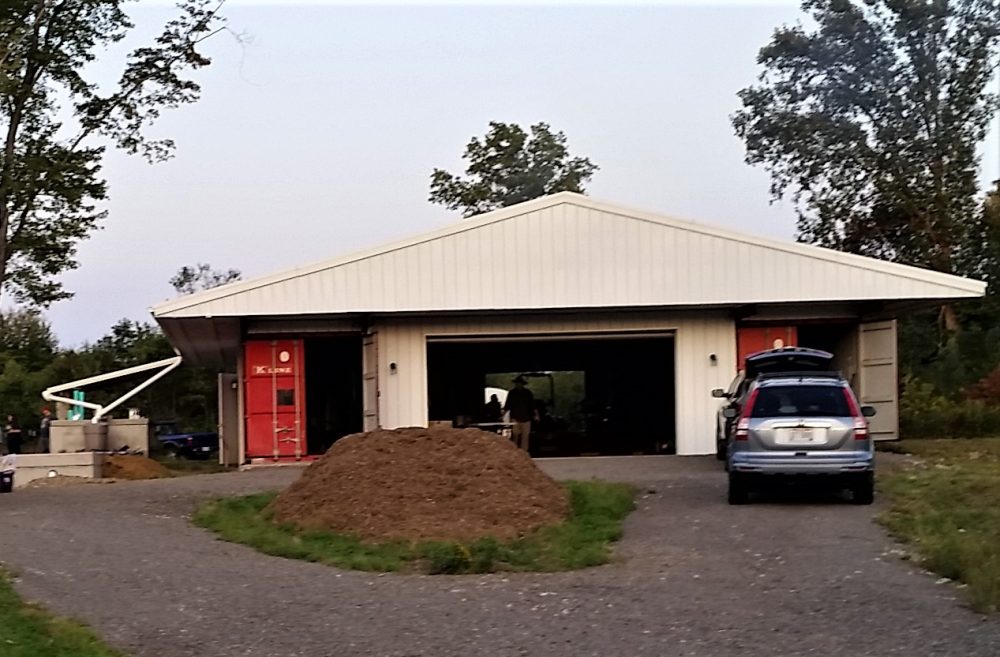
First off, water is life! This essential element, of which all of us are mostly composed of, is paramount to nearly any permaculture design. It is the difference between a lush, productive jungle and a desert. This is why most permaculture designs should start with water and access, and why we always make sure everyone in our PDC courses walks away feeling confident about how to catch and store this elemental force.
The Rainwater Harvesting System
The purpose of this catchment system will be to provide potable water to campers, guests, students and residents for showering, drinking and cooking while also being a reliable reservoir for the watering of nearby gardens when needed.
As you can see from the picture above the roof area is quite large. The barn is 50′ x 65′ which makes each side of the barn 25′ x 65’. Four 1,000 gallon cisterns were purchased and half-buried into the ground to prevent winter freezing, with the soil acting as a blanket to mitigate those deep freezes. Bill designed this system with the assistance of Espri and Darren Bender of Brambleberry Permaculture Farm that includes a root cellar at the end (pictured below). Inside the root cellar are the valves and workings for the pumps and such.
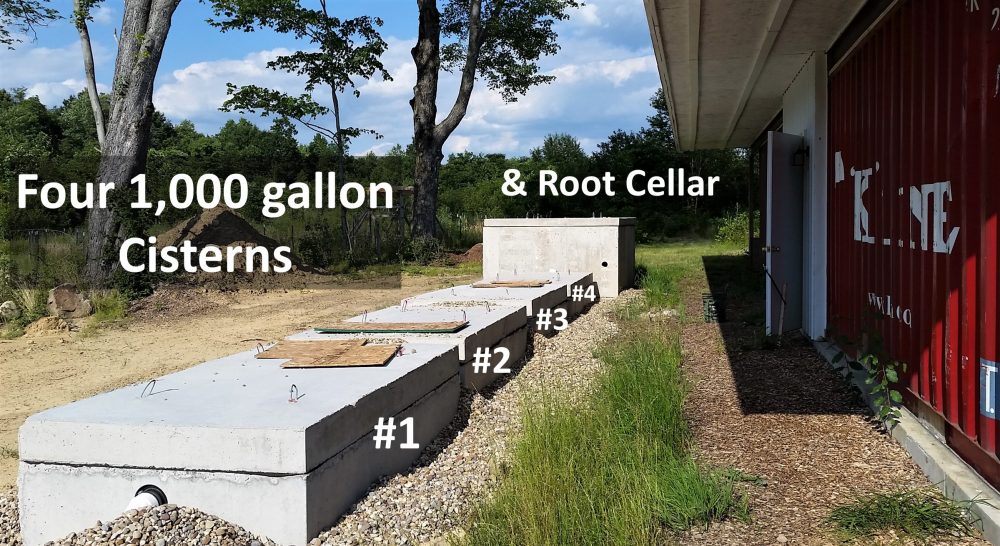
The job that Steve and I were tasked with was to get the water from the roof to these cisterns while making sure it was as clean as possible. Sediment will muck up the cisterns and require more routine maintenance. Why create more work for ourselves? Let’s design that part out…
First, we set about calculating our water flow. At my old house, where I first began catching water, I remembered that during a summer rain, two 55-gallon blue barrels would overflow in less than 2 minutes, so with a much larger roof what amount of water would we be expecting to come off the roof in a given season?
Calculations
A quick google search for “annual rainfall for Youngstown, Ohio,” and a cross checking of a few search results informed me that the average rainfall would be around 39 inches/year, which also happens to be the US average. Knowing this, we then had to calculate the square footage of our roofing. One half of the roof is 25’x 65’ which gives us 1,625 ft².
Now, here is the formula you will need once you have your data points:
Catchment Area (ft²) x Inches of Rain x 0.623 Conversion Factor = Harvested Water (Gallons)
Why 0.623? This number represents the amount of water in gallons of rain that fall upon a square foot for every inch of rain.
Calculation: 1,625 x 1″ x 0.623 = 1,012 gallons for each inch of rainfall.
So how much rain might we harvest each year with 39″ of rainfall?
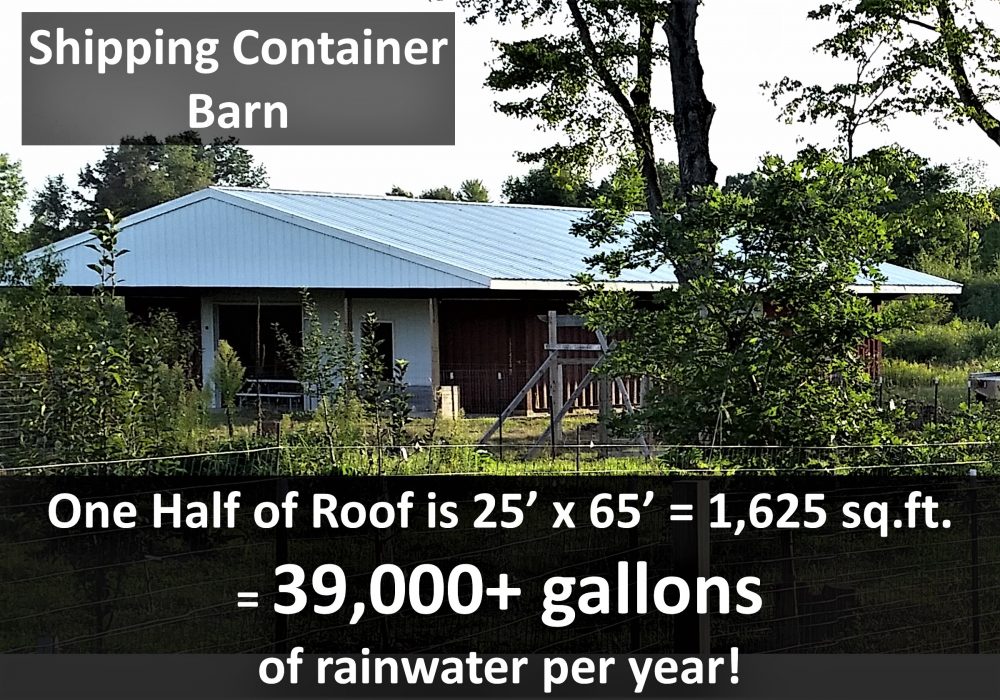
In addition to these numbers, we also constructed a 12’x12’ overhang over the root cellar (see picture below), adding another 144 ft2 to our catchment. As a challenge, why don’t you calculate what this added roof space will collect? Getting your hands on the formula will help you remember, so don’t scroll down until you’ve got it!
Pause for Calculation.
Got it now?
This overhang resulted in an additional 90 gallons for every inch of rain, and 3,510 gallons per average year, bringing our average annual total to almost 43,000-gallons/year. That’s an impressive amount of water, and given that the average American uses about 80-100 gallons of water per day — and us permies can certainly do better than that — this should be more than enough water to take care of our human needs and water the gardens with the surplus.
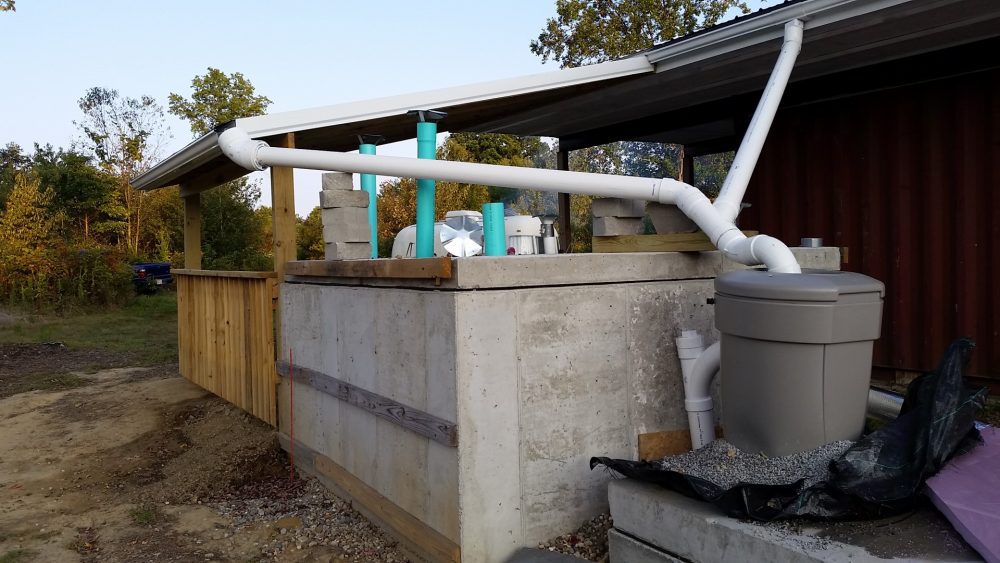
So the first things we did was to install the gutters and gutter guards, which are the first line of defense against organic matter entering the cisterns.
Due to the large amount of rainwater coming through the system we decided to use 4-inch, schedule 40 PVC pipe to channel the water from the gutters to the cisterns. This width of pipe will ensure the system is not overwhelmed, even in the heaviest of rains.
First-Flush Diversion
Between your catchment and storage system there needs to be some kind of ‘first-flush’ diverter which allows any of the smaller, particulate matter (dust, pollen, bird scat, etc.) to be washed away before the water begins to enter the cisterns. For smaller systems, such as most residential homes, there are plenty of online resources for purchasing kits. I like Rain Brothers LLC out of Columbus, Ohio, as they are local (in regards to this project and where my business is based), very responsive, and have excellent pricing.
Here’s what you need to know about first-flush diverting — The amount of water diverted should be a minimum of 12.5 gallons per 1000 square feet of roof area (or 0.0125 gallons per square foot). You also need to consider the amount of possible contaminants. For example, if your house is surrounded by trees, then the amount of grime and litter could be substantial, and you will want to increase that number by up to 0.05 gallons per square foot at a maximum.
Now that we understand all of this, and with our estimation that our roof catchment at Bending Oak is 1,769 ft², and our contaminants are minimal, let’s calculate how much water we would need to divert in order to catch clean water…
1,769ft2 x 0.0125 = 22.11 gallons of first flush diversion per rain event
Now in terms of first flush diversion, most pre-fab kits are meant for residential homes where they will only need a few gallons of diversion. We had to design something ourselves, and this blend of math, utility and creativity is exactly why I love doing this kind of work. It really “melts my butter” (as Bill says).
We decided to use a pre-fabricated rain barrel with an overflow set at about halfway, meaning that the 50 gallon barrel would have to fill to about 25 gallons before it began to overflow into the cistern. These pre-fab barrels come with a filter on the top (litter screen), adding a third layer of filtration before our collected water reaches storage. We drilled additional 1/16” holes to the screen to insure that it would never become overrun by a peak flow (picture below). There needs to be enough holes so that not only can the water get in during a heavy flow, but the air inside the barrel, which is being displaced, has ample route to escape.
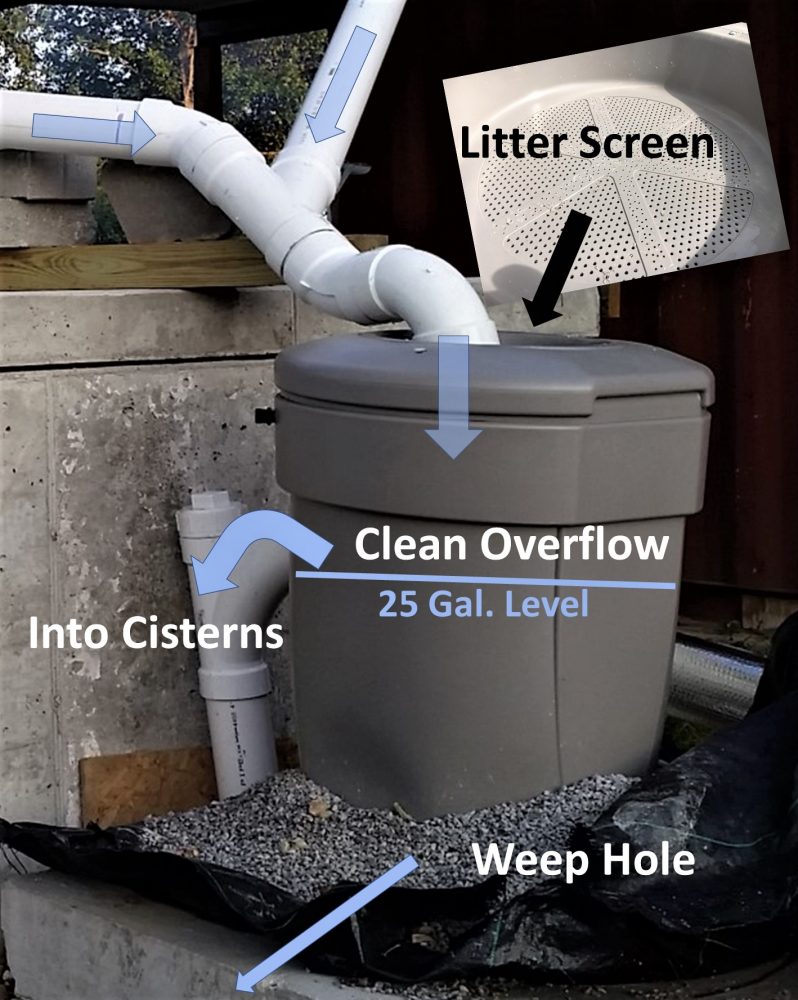
We also added a spigot near the bottom and opened the valve just a bit (known as the weep hole) so that following each rain event the barrel will slowly empty (watering nearby plants) and become ready to receive the first flush from the next rainfall event.
Here is a picture of the entrance we built down into the root cellar. Where before there was a mud pit, now there’s a retaining wall and gravel steps – much more inviting and comfortable to access!

To finish the system we still need to hook up the electrical and water lines, bury the cisterns with 2 feet of soil, add a living roof to the root cellar, as well as insulate and stucco the root cellar walls.
What’s Next
I hope this was helpful, and I look forward to getting your feedback. What sort of rain catchment systems have you worked with or seen work? What have you learned? Share your questions, innovations and observations!
Thanks…
– E
P.S. We discuss all of this and a whole lot more at every one of our PDC courses. We would love to have you join us at one. Here is the upcoming schedule.
